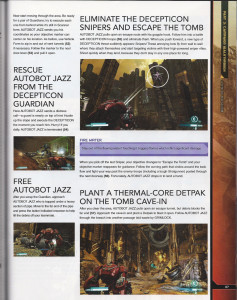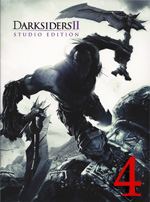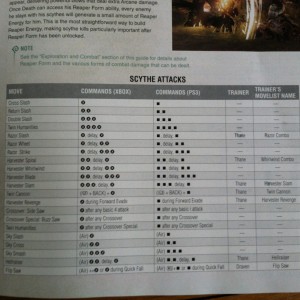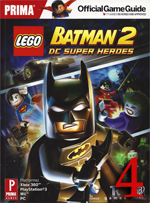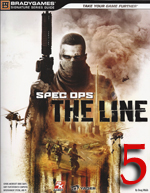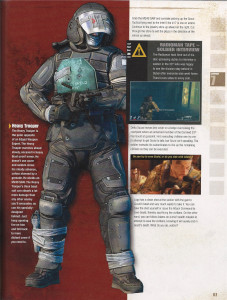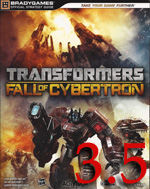 For the most part, the Transformers: Fall of Cybertron strategy guide is okay. Much like the game itself, the strategy guide does nothing to really go above and beyond what is expected for an action game. The general walkthroughs exist, collectibles are listed, and multiplayer maps are presented. While all of the information is correct, the strategy guide never took that extra step in giving the player everything possible to complete the game to 100% for Achievements and Trophies. In this day and age, this is a downright necessity for all console strategy guides–with the exception of guides for Wii-only games. In addition, typos and really odd ways of saying Transformers’ names suggest that not much research or quality assurance went into the guide either. Yes, all of the information within the guide is accurate, but the Transformers: Fall of Cybertron strategy guide as a whole lacks that extra polish and completionist material that makes it truly a useful guide.
For the most part, the Transformers: Fall of Cybertron strategy guide is okay. Much like the game itself, the strategy guide does nothing to really go above and beyond what is expected for an action game. The general walkthroughs exist, collectibles are listed, and multiplayer maps are presented. While all of the information is correct, the strategy guide never took that extra step in giving the player everything possible to complete the game to 100% for Achievements and Trophies. In this day and age, this is a downright necessity for all console strategy guides–with the exception of guides for Wii-only games. In addition, typos and really odd ways of saying Transformers’ names suggest that not much research or quality assurance went into the guide either. Yes, all of the information within the guide is accurate, but the Transformers: Fall of Cybertron strategy guide as a whole lacks that extra polish and completionist material that makes it truly a useful guide.
The walkthroughs themselves are impeccable. like War for Cybertron, Fall of Cybertron (FoC) is pretty linear as where to go with a straightforward story and mission parameters. This time around, though, FoC has more collectibles, and as a result, the layout of the levels is far more conducive to exploration. There are two sets of collectibles, audio files and blueprints, and while some are strewn out in the middle of the player’s path, several require venturing to the roads less traveled by. Players who follow the strategy guide by the letter will pick up every collectible their first try without a problem. Even if you miss a few, the game allows you to play any chapter at any time, so it’s simple to backtrack and pick up wayward blueprints and audio files. As an added bonus, the guide included a screenshot of where the collectible is, which was immensely appreciated, especially when I got lost in the corridors a time or two.
The strategy guide was also really great at pointing out any Easter Eggs and little fun morsels the developers threw in just for fun. For example, there are a few times where Soundwave and his tape deck minions spy on Autobots, and unless you know where to look, you’ll miss them entirely. They don’t add anything to the story or even to the gameplay, but it was funny to catch Soundwave spying on me and hear him yell, “Autobots inferior! Soundwave superior!” as he ran away. Also, I would have completely missed Frenzy running on a conveyor belt in Soundwave’s lab like it was a treadmill, if not for the guide. Again, it doesn’t add anything, but it’s fun, like most Easter Eggs. In this case, the Easter Eggs were arcade mini-games that were quite well hidden in a few of the levels.
While the Fall of Cybertron strategy guide did so many things well, it’s hard to overlook so many things that came off as lazy and sloppy. For example, the fact that the write misspelled Arcee’s name as “Acree” when pointing out her random pinup poster is a bit unforgivable. This is the one time in the entire game/guide that she is even mentioned, and it’s in a callout box in gold…highlighting the mistake for the world to see. I cringed when I saw it. No other Transformers’ names were misspelled, but I’m really curious as to why a couple of the Autobots’ names contained “Autobot” before the name, as shows in the image on the left. Why in the world would he be called “Autobot Jazz”? I gave the guide the benefit of the doubt before I judged too harshly, and checked to see what the game called him, both in spoken dialogue and in the subtitles. In both instances, he was just called Jazz, thereby making it incredibly ridiculous for the guide to label him this way. The guide called him “Autobot Jazz” in every instance, not just one or two times. “Autobot Ratchet” received the same treatment. Oddly enough, no Decepticons were given the “Decepticon” prefix before their names.
The biggest disappointment of the entire guide was the lack of Achievement/Trophy help. Each chapter charges players with a specific challenge to get a random Achievement/Trophy. For example, in Chapter III, the special Achievement requires players to “take out a cluster of eight Decepticons using Metroplex’s Air Strike.” The strategy guide never once calls attention to this Achievement in the walkthrough. It never mentions the player can get a special Achievement here, never suggests the best spot to try to snag it, and never suggests a best method to go about doing it. In the back of the guide, where the Achievements are listed in a nice table, the guide offers zero advice on how to earn each Achievement. What is the point of having a strategy guide if there are no strategies for how to obtain 100% in Achievements and Trophies? For many people, this is all they want out of any form of help in the first place.
This lack of Achievement/Trophy support clouded over most of everything else the Transformers: Fall of Cybertron strategy guide did very well, and the sloppiness with the Transformer names only darkened the clouds. As much as the strategy guide nailed the walkthroughs and the hunt for collectibles, it didn’t go that extra mile to give the player all the tools needed to complete the game to 100%. In the end, it left me with lots of disappointment.
SGR Rating: 3.5/5
Author: Rick Barba
Publisher: BradyGames
Editions available: Paperback
Acquired via Publisher

